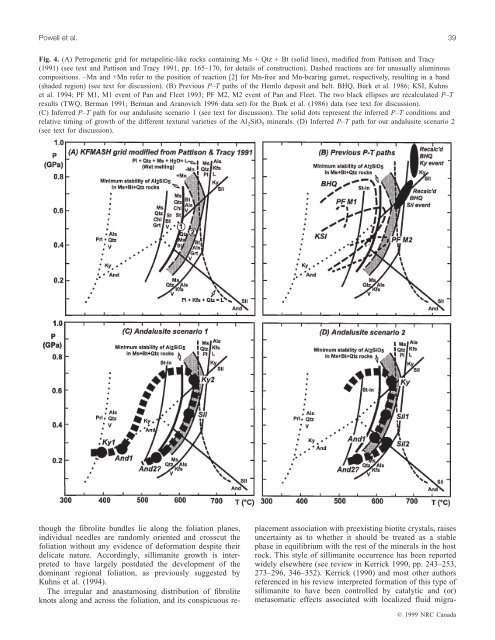Metamorphic history of the Hemlo gold deposit from Al2 SiO5 ...
Metamorphic history of the Hemlo gold deposit from Al2 SiO5 ...
Metamorphic history of the Hemlo gold deposit from Al2 SiO5 ...
You also want an ePaper? Increase the reach of your titles
YUMPU automatically turns print PDFs into web optimized ePapers that Google loves.
Powell et al. 39<br />
Fig. 4. (A) Petrogenetic grid for metapelitic-like rocks containing Ms + Qtz + Bt (solid lines), modified <strong>from</strong> Pattison and Tracy<br />
(1991) (see text and Pattison and Tracy 1991, pp. 165–170, for details <strong>of</strong> construction). Dashed reactions are for unusually aluminous<br />
compositions. –Mn and +Mn refer to <strong>the</strong> position <strong>of</strong> reaction [2] for Mn-free and Mn-bearing garnet, respectively, resulting in a band<br />
(shaded region) (see text for discussion). (B) Previous P–T paths <strong>of</strong> <strong>the</strong> <strong>Hemlo</strong> <strong>deposit</strong> and belt. BHQ, Burk et al. 1986; KSI, Kuhns<br />
et al. 1994; PF M1, M1 event <strong>of</strong> Pan and Fleet 1993; PF M2, M2 event <strong>of</strong> Pan and Fleet. The two black ellipses are recalculated P–T<br />
results (TWQ, Berman 1991; Berman and Aranovich 1996 data set) for <strong>the</strong> Burk et al. (1986) data (see text for discussion).<br />
(C) Inferred P–T path for our andalusite scenario 1 (see text for discussion). The solid dots represent <strong>the</strong> inferred P–T conditions and<br />
relative timing <strong>of</strong> growth <strong>of</strong> <strong>the</strong> different textural varieties <strong>of</strong> <strong>the</strong> Al 2 SiO 5 minerals. (D) Inferred P–T path for our andalusite scenario 2<br />
(see text for discussion).<br />
though <strong>the</strong> fibrolite bundles lie along <strong>the</strong> foliation planes,<br />
individual needles are randomly oriented and crosscut <strong>the</strong><br />
foliation without any evidence <strong>of</strong> deformation despite <strong>the</strong>ir<br />
delicate nature. Accordingly, sillimanite growth is interpreted<br />
to have largely postdated <strong>the</strong> development <strong>of</strong> <strong>the</strong><br />
dominant regional foliation, as previously suggested by<br />
Kuhns et al. (1994).<br />
The irregular and anastamosing distribution <strong>of</strong> fibrolite<br />
knots along and across <strong>the</strong> foliation, and its conspicuous replacement<br />
association with preexisting biotite crystals, raises<br />
uncertainty as to whe<strong>the</strong>r it should be treated as a stable<br />
phase in equilibrium with <strong>the</strong> rest <strong>of</strong> <strong>the</strong> minerals in <strong>the</strong> host<br />
rock. This style <strong>of</strong> sillimanite occurrence has been reported<br />
widely elsewhere (see review in Kerrick 1990, pp. 243–253,<br />
273–296, 346–352). Kerrick (1990) and most o<strong>the</strong>r authors<br />
referenced in his review interpreted formation <strong>of</strong> this type <strong>of</strong><br />
sillimanite to have been controlled by catalytic and (or)<br />
metasomatic effects associated with localized fluid migra-<br />
© 1999 NRC Canada
















